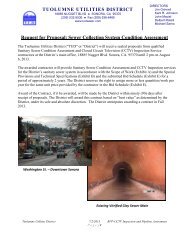Historic Resource Evaluation Project - Tuolumne Utilities District
Historic Resource Evaluation Project - Tuolumne Utilities District
Historic Resource Evaluation Project - Tuolumne Utilities District
You also want an ePaper? Increase the reach of your titles
YUMPU automatically turns print PDFs into web optimized ePapers that Google loves.
For Criterion C, according to JRP and Caltrans:<br />
Water conveyance systems have been found eligible for the NRHP under<br />
Criterion C for their engineering or design values. Examples of different<br />
types, periods, or methods of construction; … and properties which<br />
together constitute a historic district may be eligible under Criterion C …<br />
or be the best or good examples of a type of property. The earliest, best<br />
preserved, largest, or sole surviving examples of particular types of water<br />
conveyance systems or a property that introduced a design innovation may<br />
be eligible as examples of evolutionary trends in engineering (JRP and<br />
Caltrans 2000:93-94).<br />
The evaluation procedures go on to state:<br />
Water conveyance systems that appear to meet the National Register<br />
criteria must also retain integrity, which is the ability of a property to<br />
convey its significance…. To address integrity, the appearance of the<br />
water system and its design during its period of significance must be<br />
known and the following questions should be asked: Does the system<br />
follow the alignment of its period of significance? Have the significant<br />
elements of design, materials, and workmanship been retained? Does the<br />
setting still evoke the important qualities of the water system? And does<br />
the property retain the feeling and associations needed to convey its<br />
significance?...<br />
As with other types of historic properties, the fundamental test of the<br />
integrity of a water conveyance system consists of the relationship<br />
between its current appearance and its appearance during the period of its<br />
significance. Integrity will not be lost as the result of modifications that<br />
were undertaken during the system’s period of significance, and<br />
modifications made within that time may actually contribute to the<br />
importance of the property. Subsequent repairs or modifications may have<br />
greater effects on the system’s integrity than abandonment and<br />
deterioration of the system… (JRP and Caltrans 2000:95).<br />
In California, eligible ditches range from small stream diversions for ranches and farms,<br />
to abandoned mining enterprises, to enormous governmental undertakings. The complex<br />
of ditches, canals, tunnels, and weirs that organize the Santa Ana River waters near<br />
Redlands were determined eligible for National Register listing as part of two district<br />
nominations. One included more than 15 irrigation canals and another added powergeneration<br />
systems to an existing nomination for the powerhouses (Hornbeck and Botts<br />
1988). In 1992, Caltrans recorded the 340-mile long Los Angeles Aqueduct as sites CA-<br />
INY-459H, CA-MNO-2753H, and CA-LAN-2105H (trinomials change with county)<br />
(Costello and Marvin 1992).<br />
Foothill <strong>Resource</strong>s, Ltd. 4.2 TUD Ditch Sustainability <strong>Project</strong><br />
Francis Heritage, LLC<br />
<strong>Historic</strong> <strong>Resource</strong> <strong>Evaluation</strong> Report




